GM’s new Corvette Concept is a futuristic sports car vision for the road and track of tomorrow
General Motors has a new UK design studio. We took a visit and sampled its debut project, an all-new Corvette concept

This dramatic machine is the first of three advanced design concepts exploring the visual language of the iconic Chevrolet Corvette, was designed in General Motors’ new UK Advanced Design Studio. Wallpaper* travelled to Leamington Spa, in the heart of the UK’s auto industry, to visit this impressive new facility and meet the designer who helms it, Julian Thomson.
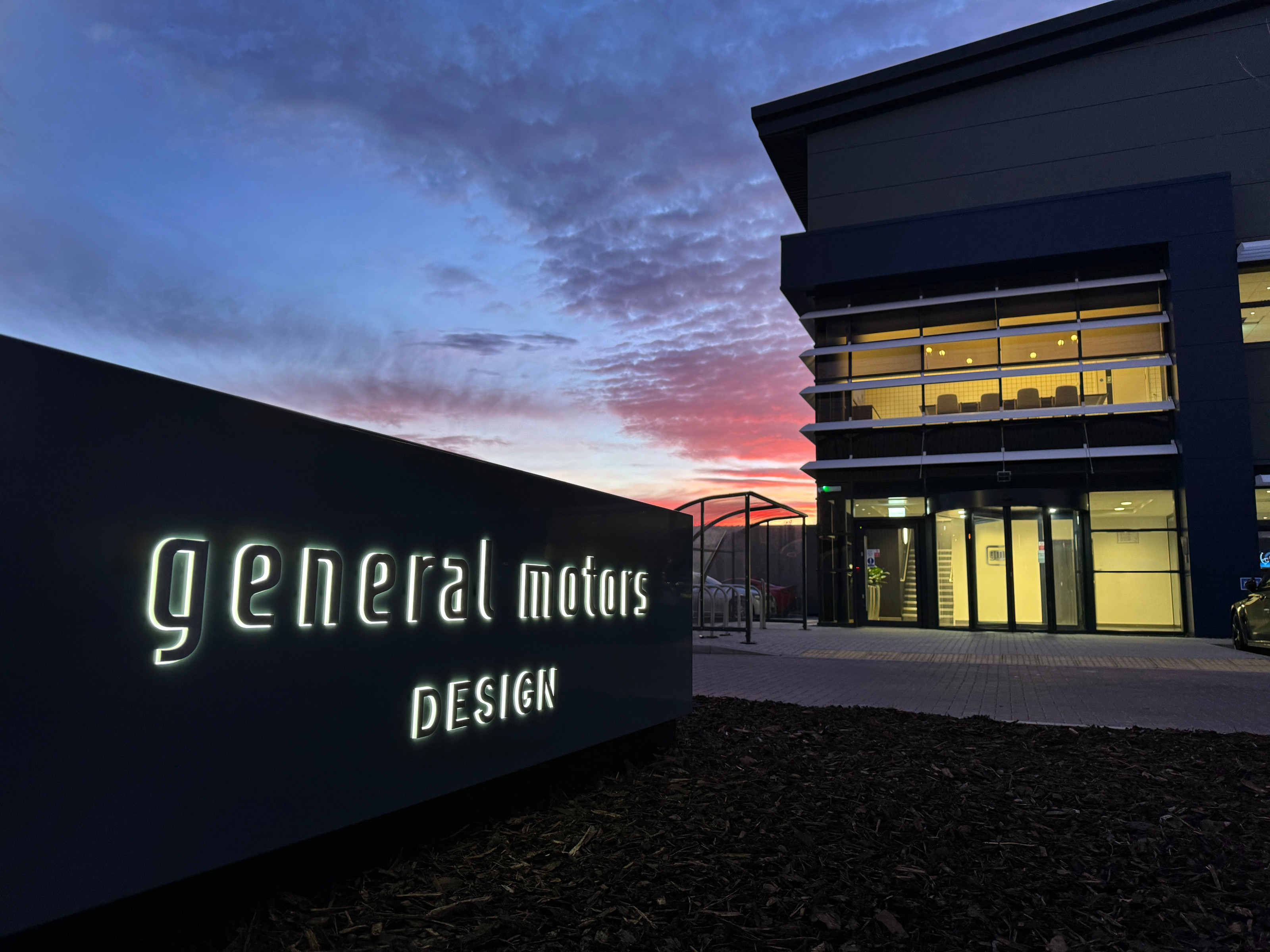
General Motors Advanced Design UK
The big sheds of this nondescript industrial park give little hint as to what lies within, an anonymity that’s just what this notoriously secretive industry prefers. The only clues, apart from the signage, are the diverse and eclectic line-up in the staff car park – a Mk1 Range Rover, an Alpine A110 and a rare (in the UK) example of the current generation Corvette, the C8. The new Corvette concept takes pride of place in the cavernous 25,000 square foot studio, a sleek form emerging from GM’s decision to cast the net far and wide in its search for future forms.
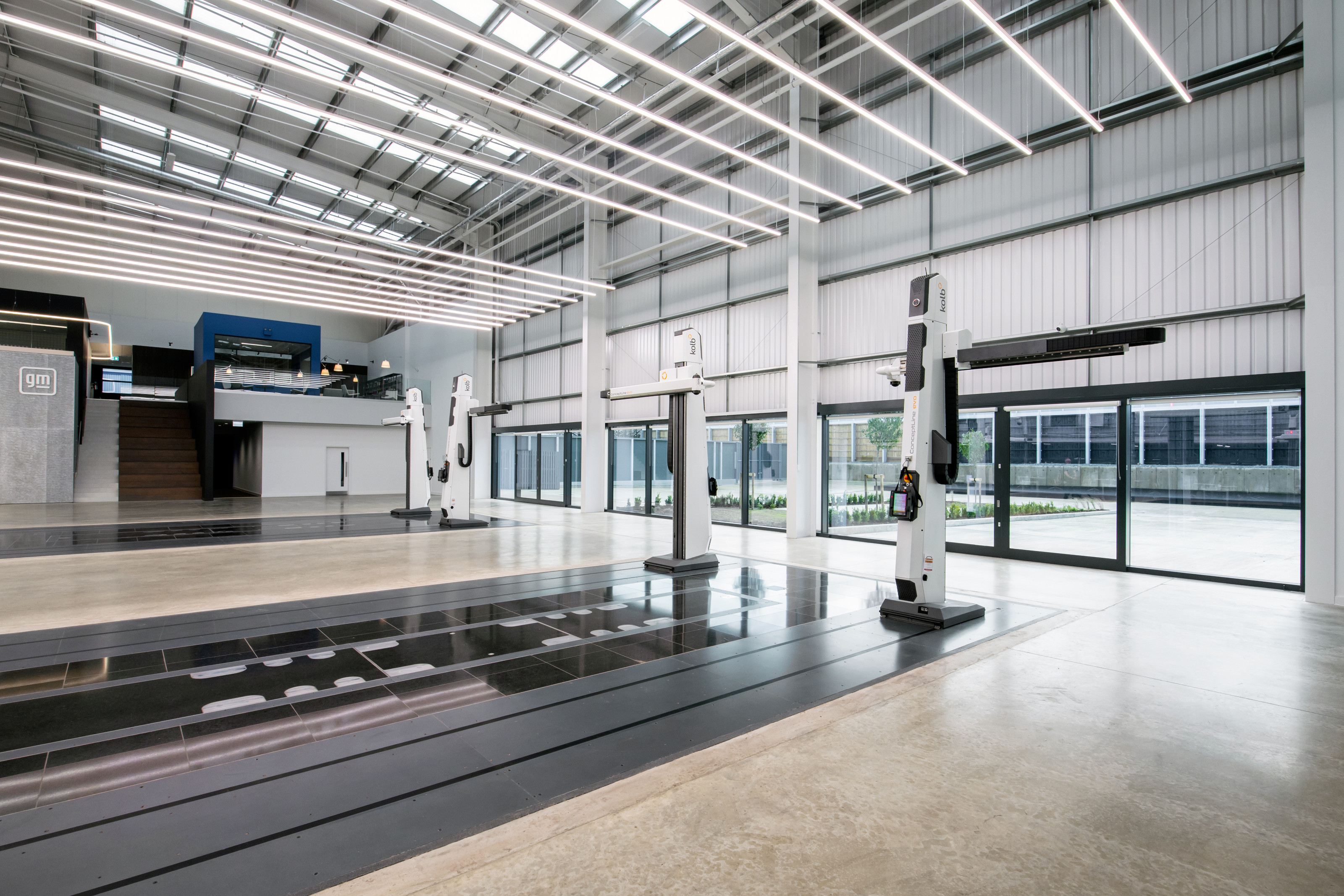
Inside General Motors Advanced Design UK
The new studio demonstrates the investment in skill, technology and infrastructure required before you can even start to put virtual pen to paper. Designing beautiful things is a journey that requires investment, patience and trust. Making things is even harder. The new UK studio becomes part of a global network that includes GM’s design HQ in Warren, Michigan – the Eero Saarinen-designed Technical Center – and a satellite studio in Pasadena. There are also dedicated design facilities in Shanghai, Sao Paolo and Incheon, South Korea. The UK base also serves as a gateway for bringing European talent into the larger GM ecosystem, with close ties to design schools like the nearby Coventry University and London’s RCA.
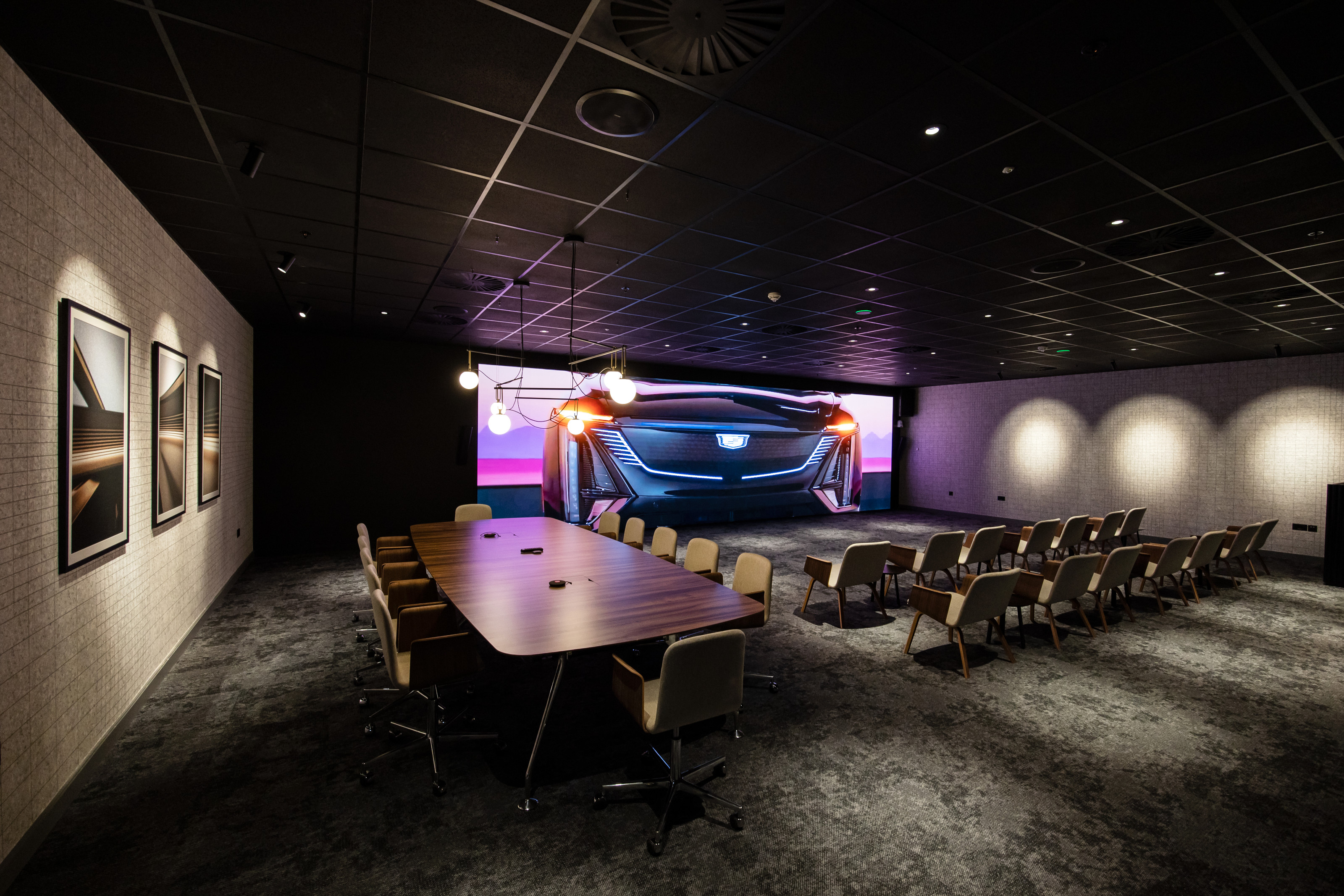
Inside General Motors Advanced Design UK
GM’s brand stable has been depleted in recent years, mostly at the expense of European buyers. The company remains committed to bringing luxury brands like Cadillac and Corvette to European markets, but whether the recently shifted political sands will frustrate these ambitions remains to be seen. Nevertheless, at the time of our interview, the company was set to open eight dedicated Corvette centres around the UK, all catering to selling and servicing the first ever right-hand drive version of the Corvette, the C8.
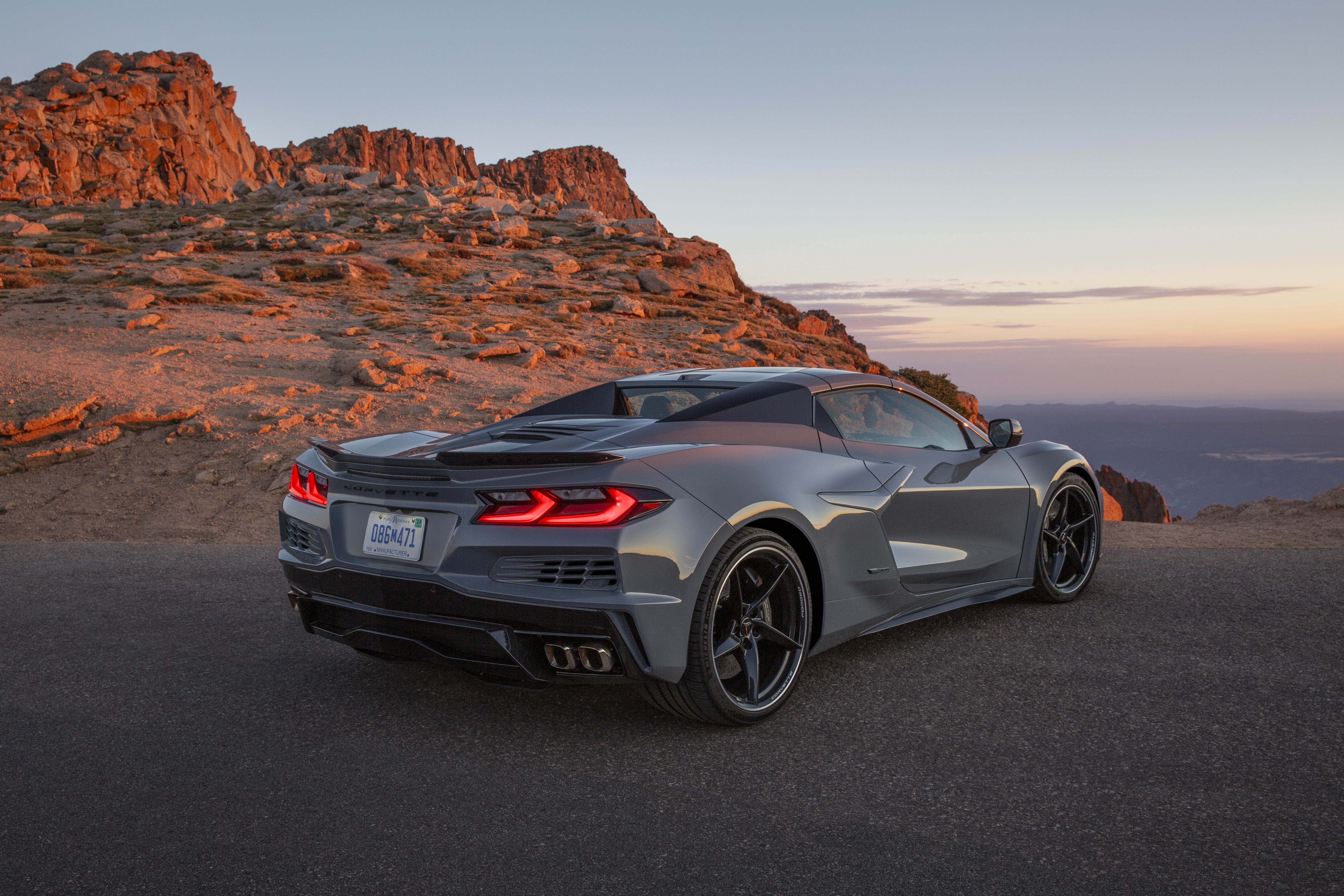
2024 Corvette E-Ray 3LZ convertible
Although the new UK studio isn’t specifically tasked with serving Europe, the insight and foothold it garners from these markets is undeniably important. Michael Simcoe, currently Senior Vice President of Global Design at GM, but just a few weeks from retirement after over four decades with the company, also notes that the feasibility of setting up in the UK was essentially predicated on the availability of Julian Thomson.

Julian Thomson, head of General Motors Advanced Design UK
Thomson begins his presentation with a well-chosen but provocative statement: ‘GM invented car design.’ It was way back in 1927 that one Harley Earl was given the reigns of what was then dubbed the Art and Color Department, a dedicated space devoted to making bodywork sleeker, chrome brighter and interiors more inviting. Earl is an intriguing figure, skilled at both design and marketing but also enormously self-aggrandising.
One oft-repeated tale tells of how a youthful Earl invented the sculptural car design modelling process by dredging clay from a local riverbed and making it into scale maquettes. What’s undeniable, however, is that Earl not only realised the importance of how a car looked but ensured that customers were aware that this look was continuously evolving, a visual chronology of modernity, culture and status.
Wallpaper* Newsletter
Receive our daily digest of inspiration, escapism and design stories from around the world direct to your inbox.
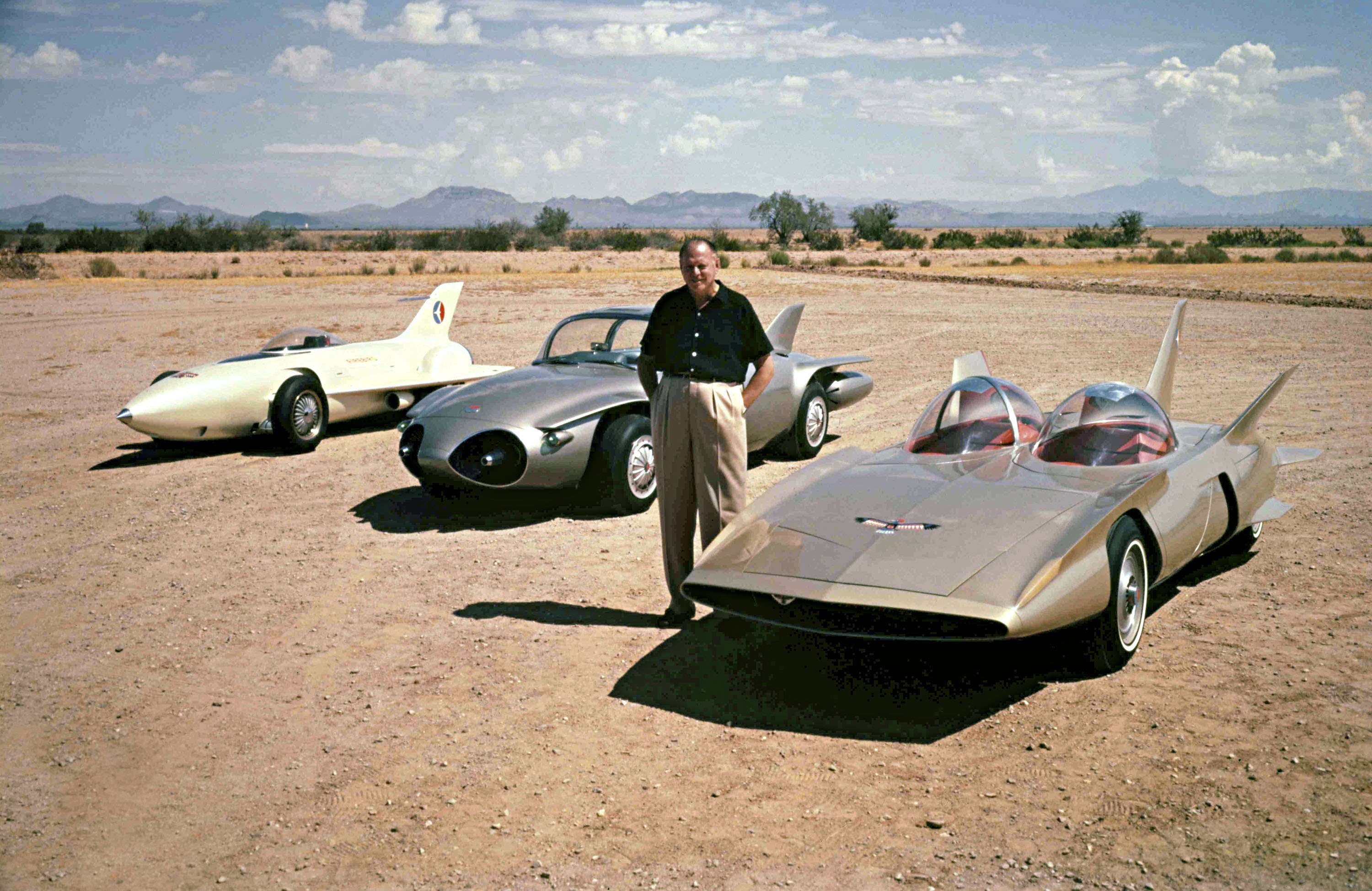
Harley Earl and the three GM Firebird concepts, c1959
GM began in 1908 as a way of consolidating the huge number of early automobile manufacturers, but over time the smaller names have dropped off the radar and out of the dealership. Right now, GM’s brand portfolio consists of Cadillac, Buick, GMC, and Chevrolet along with high profile sub-brands like Hummer and Corvette. The company also has a stake in Chinese brands Baojun and Wuling, building on a relationship with China that goes back to the 1910s when Buick became one of the first and most highly favoured brands in the country.
Even in the modern era, GM's brand portfolio has been substantially winnowed, with once familiar names like Oldsmobile, Saturn, Holden, Pontiac and Saab passing into oblivion. GM’s two biggest European brands, Vauxhall and Opel, are now part of Stellantis, a schism that also cost the American company its creative footing in the UK car industry. Hence the need for an all-new studio.
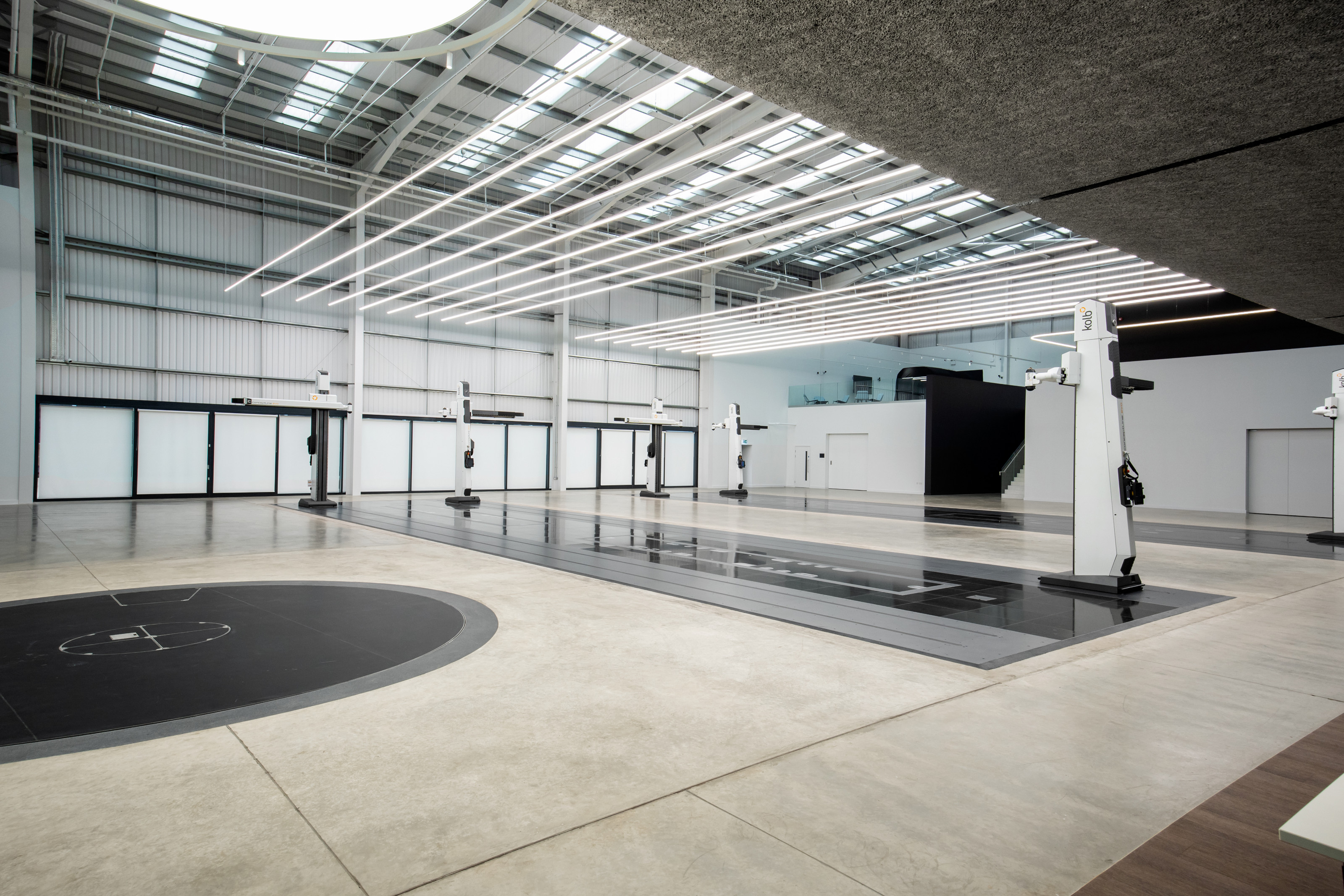
Inside General Motors Advanced Design UK
The reasons for Thomson’s availability are beyond the scope of this piece. With a career including significant spells at Ford, Lotus and Volkswagen, Thomson joined Jaguar in 2000 and worked closely with design director Ian Callum on some of the marque’s most successful 20th century models. He was also a design ambassador the company, overseeing Wallpaper*’s 2013 Handmade at Harrods project. Following Callum’s departure for the world of consultancy in 2019, Thomson was promoted to director of design in his place. And then Jaguar pivoted. The ready-to-go XJ flagship was canned, along with the rest of the planned product roadmap. Faced with a bold new broom sweeping through design and management, Thomson also walked, first to his own consultancy and then on to GM. Jaguar, as we all know, is taking a very different path.
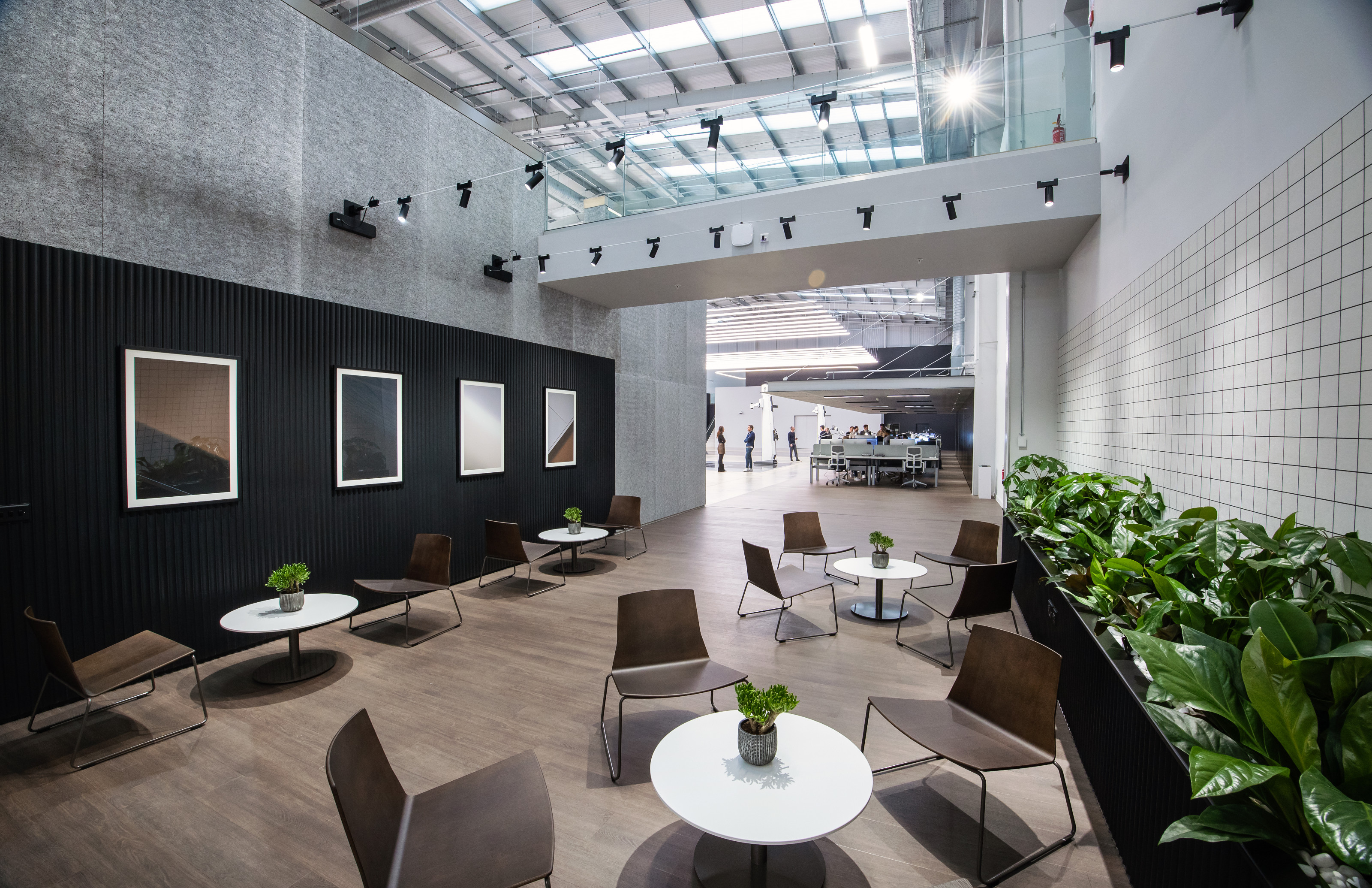
Inside General Motors Advanced Design UK
The idea of helming a new studio for GM on home turf was too good an offer to overlook. ‘It’s almost like starting your own business with a very large client,’ Thomson tells us, ‘You want to positively influence, you want to surprise as well, without annoying the wider organisation.’ Having already had experience with GM during his time at Lotus, Saab, and Opel, back when they were all connected with the company, Thomson found himself back on familiar turf. ‘I was amazed at how open and friendly it was,’ he notes.
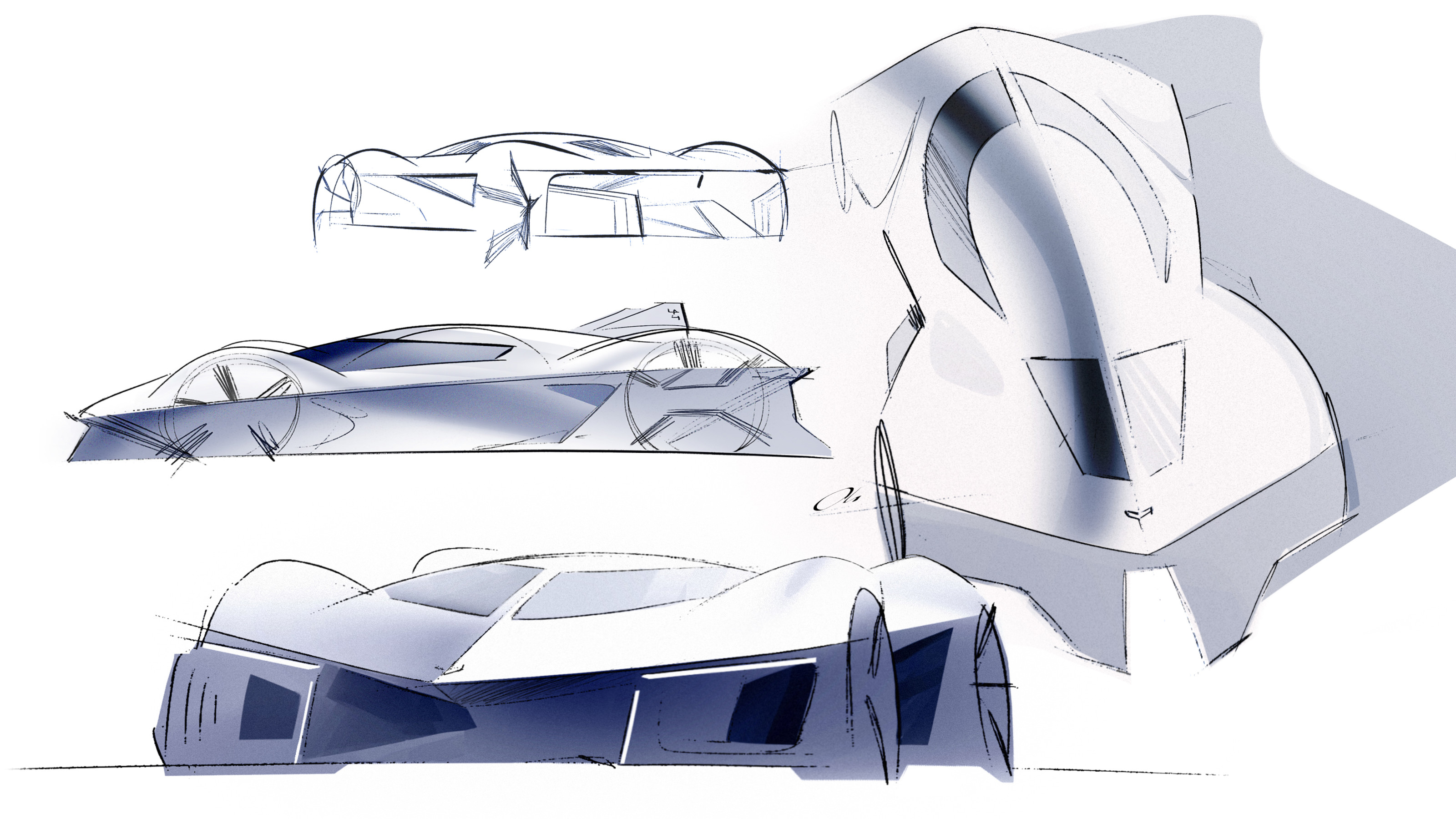
Early sketches of the Concept Corvette
Working for an American headquartered brand on an American icon was also a departure. ‘Luxury brands are always trying to reinvent themselves – Cadillac is the only one that’s done it correctly,’ Thomson notes (Jaguar watchers can read into that what they like). ‘We’re not doing European designs for Americans,’ he continues, adding that ‘American design is very influential, optimistic and positive - it’s still driven by excitement and enjoyment. How America views wealth and aspiration is very different… design is almost like an extension of the entertainment industry.’
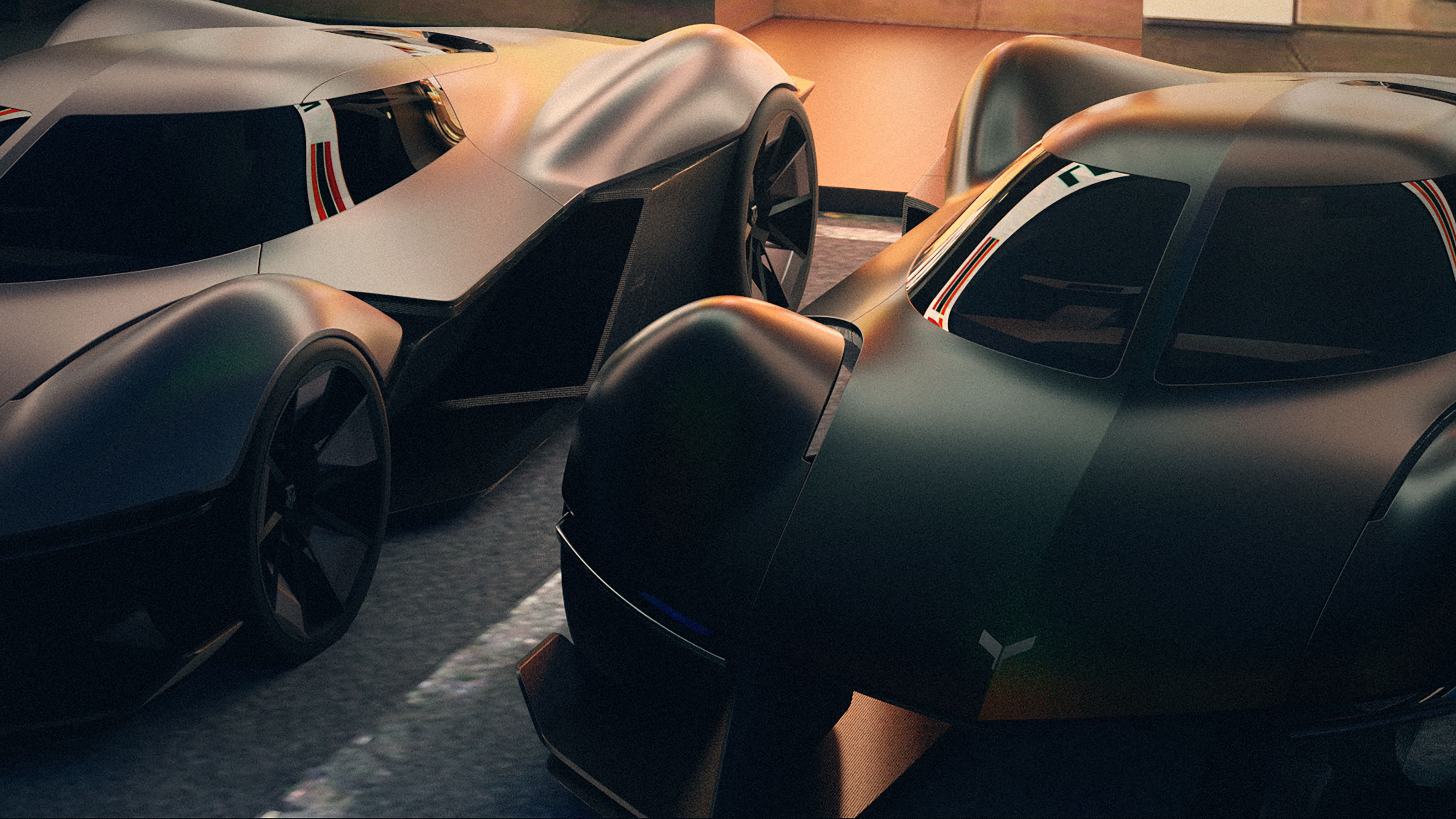
Design renders of the Concept Corvette
The Corvette Concept is a bold and high-profile way to kick off a new studio. Thomson and his team began with workshops exploring the world of this American sporting icon, along with its likely customers, old and new, and all the other elements of American design and culture that feed into the Corvette. On the one hand, there’s wide-eyed optimism but there’s also a treacly positivity and dependence on cliché, an approach that has served other industries so well. The brand film we’re shown is soundtracked by a breathy piano cover of Smells Like Teen Spirit and there’s a prominent cameo for a virtual doppelganger of Pierre Koenig’s Case Study House #22, the Stahl House, still the go-to signifier for a sleek, chic and aspirational residence some 66 years after it was finished.
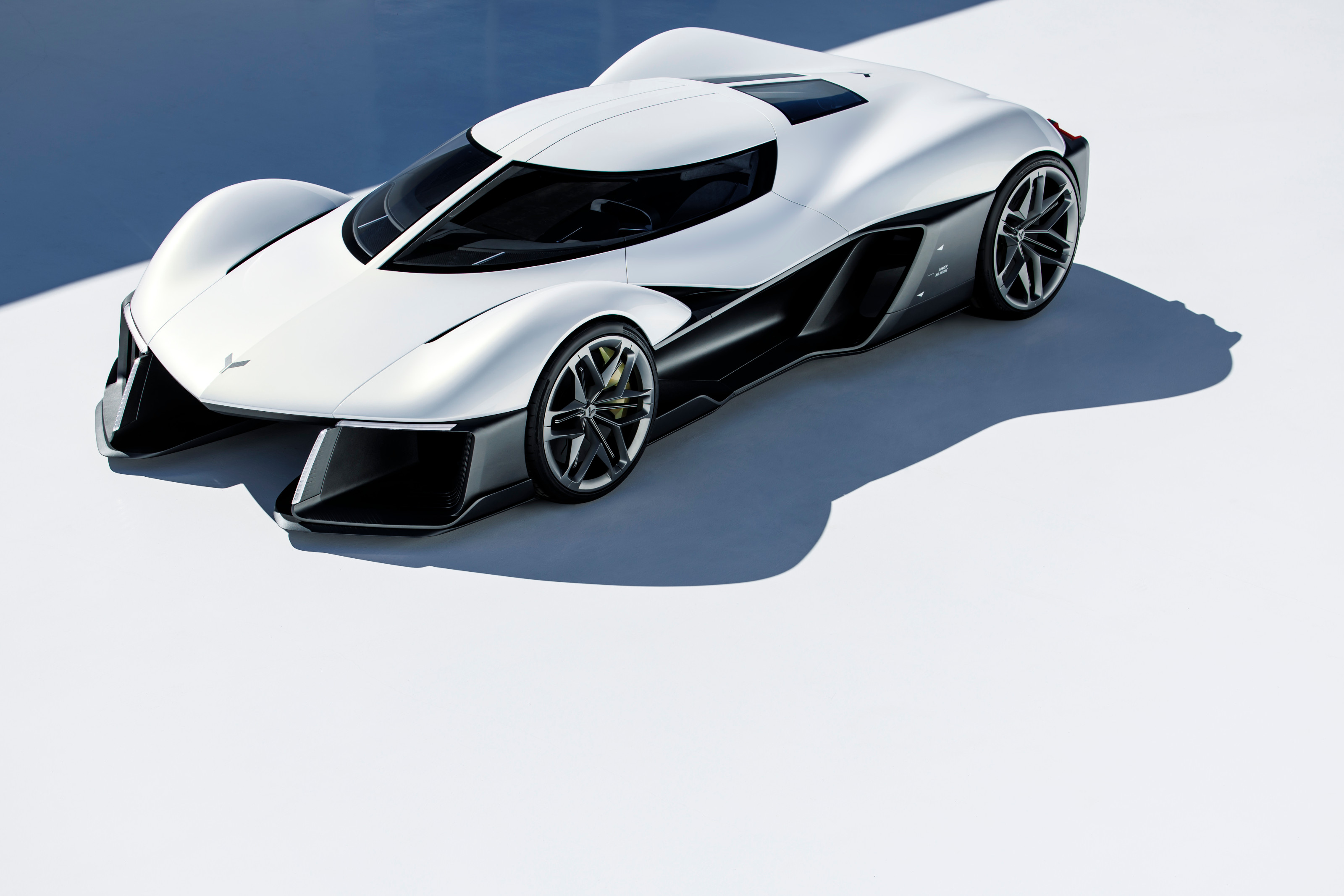
The new Corvette Concept
The end result is unveiled before us. Low, wide and sleek, it is unmistakeably a Corvette, a car that has always enhanced its sporting intentions with a visual theatricality that, on occasion, has promised more than it can deliver. These days, there’s nowhere for such empty hyperbole to hide, so a car has to go as well as it looks. Purely electric, the Corvette Concept looks powerful and purposeful. A pillar runs down the car’s central spine, splitting the windscreen and rear window, the latter in homage to the second-generation Corvette of 1963, the so-called ‘Sting Ray’ (according to then head of design Bill Mitchell, this element was initially inspired by the pre-war Bugatti Atlantique).
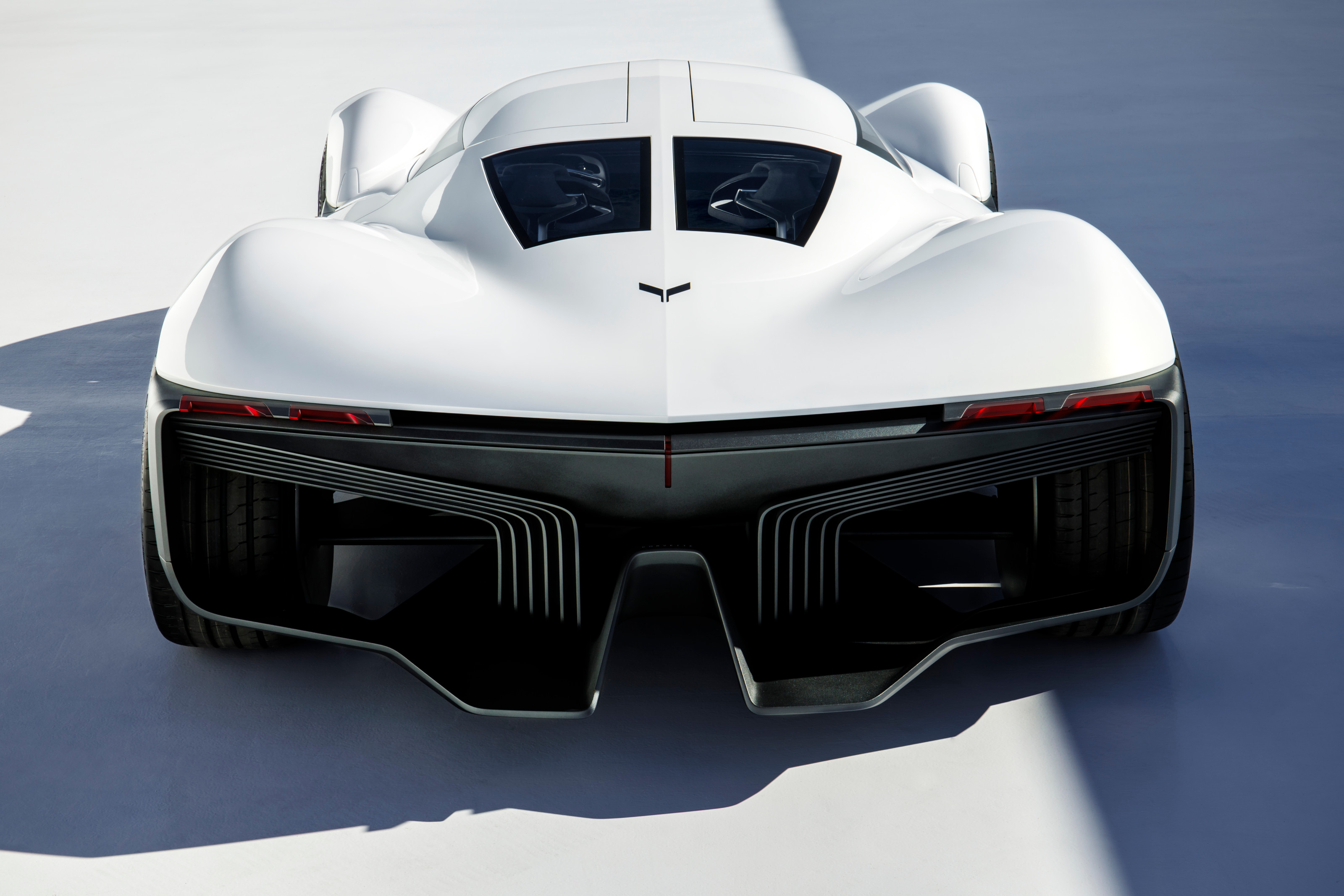
Rear view of the new Corvette Concept
In the new concept, this split is what Thomson calls ‘Apex Vision… a nod to Corvette’s centreline focus, reminiscent of today's most modern race cars. [It] emphasises a singular vertical central spine that is also a structural element, while providing a panoramic view of the road and surroundings.’ Inspiration in all its forms is an inescapable and essential part of the atmosphere at a major design studio, from the aforementioned cars in the car park to the collection of Hot Wheels toys and stacks of books and design magazines in the mezzanine library.
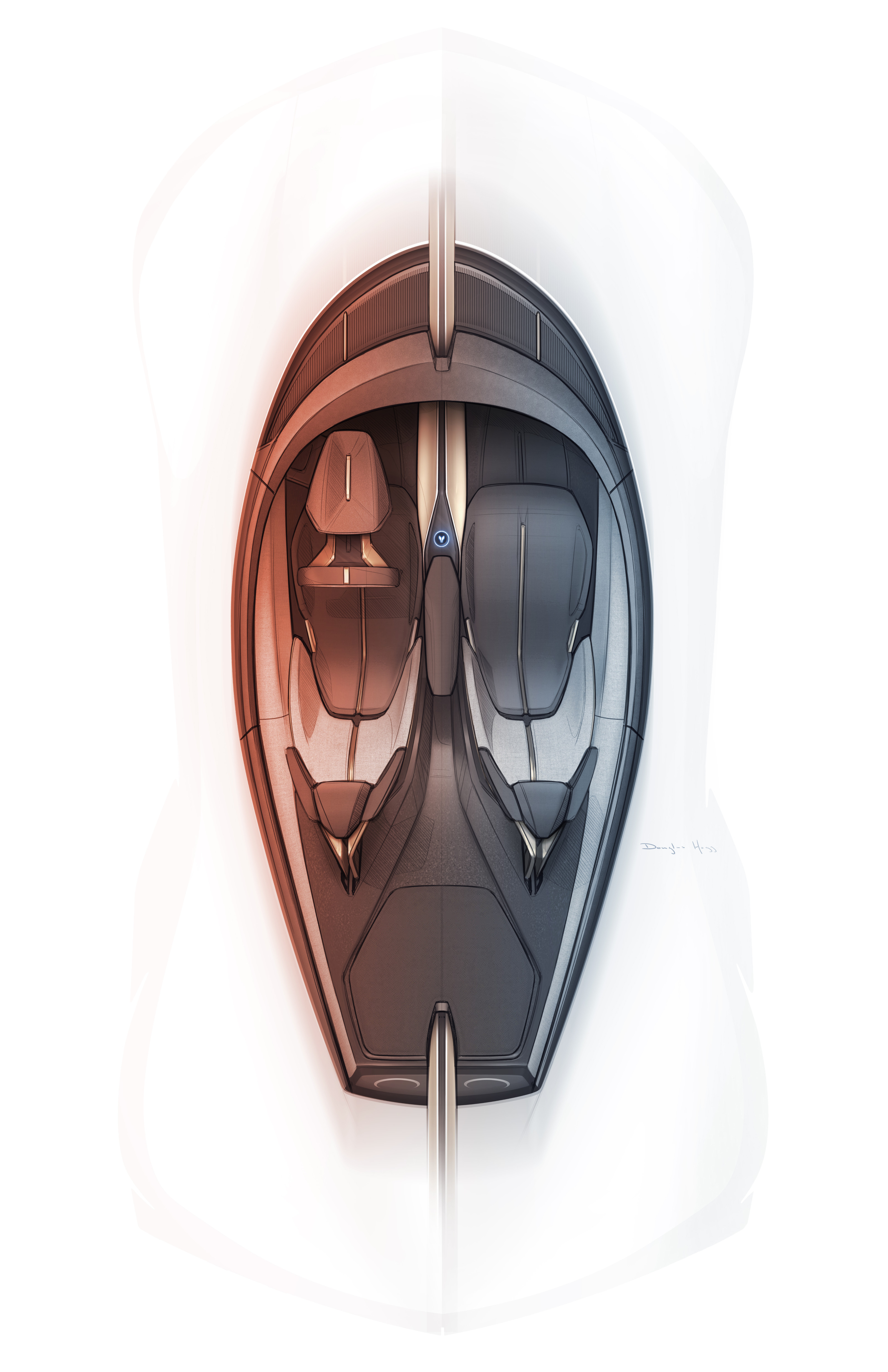
Interior top sketch of the Corvette Concept
Thomson’s team have rendered up the new Corvette concept in road and track editions, with the latter shown twisting through the legendary corkscrew curves at Laguna Seca, albeit virtually, with dynamic aero features that include extending twin vertical fins at the rear. Everything is considered, right down to the shape of the ignition key and the atmosphere and graphics of the hypothetical car configurator software. Impressively, all of the latter was also created in-house, illustrating that contemporary car design is a truly multi-disciplinary, cross-media process that might start with a sketch but often ends up with a beautifully rendered and soundtracked 4K cinematic.

Presentation material for the new Corvette Concept
Even the concept’s sound was developed by Thomson’s team, a jet-like whine bolstered by a distorted crackle, as if an amplifier was being overdriven. In fact, the new concept has strong jet aircraft influences, another nod to the Earl era, where the form of planes and rockets provided creative fuel for future design directions. The concept also embodies a very physical expression of circularity and sustainability in the use of recycled race tyres to create the 3D printed substructure.
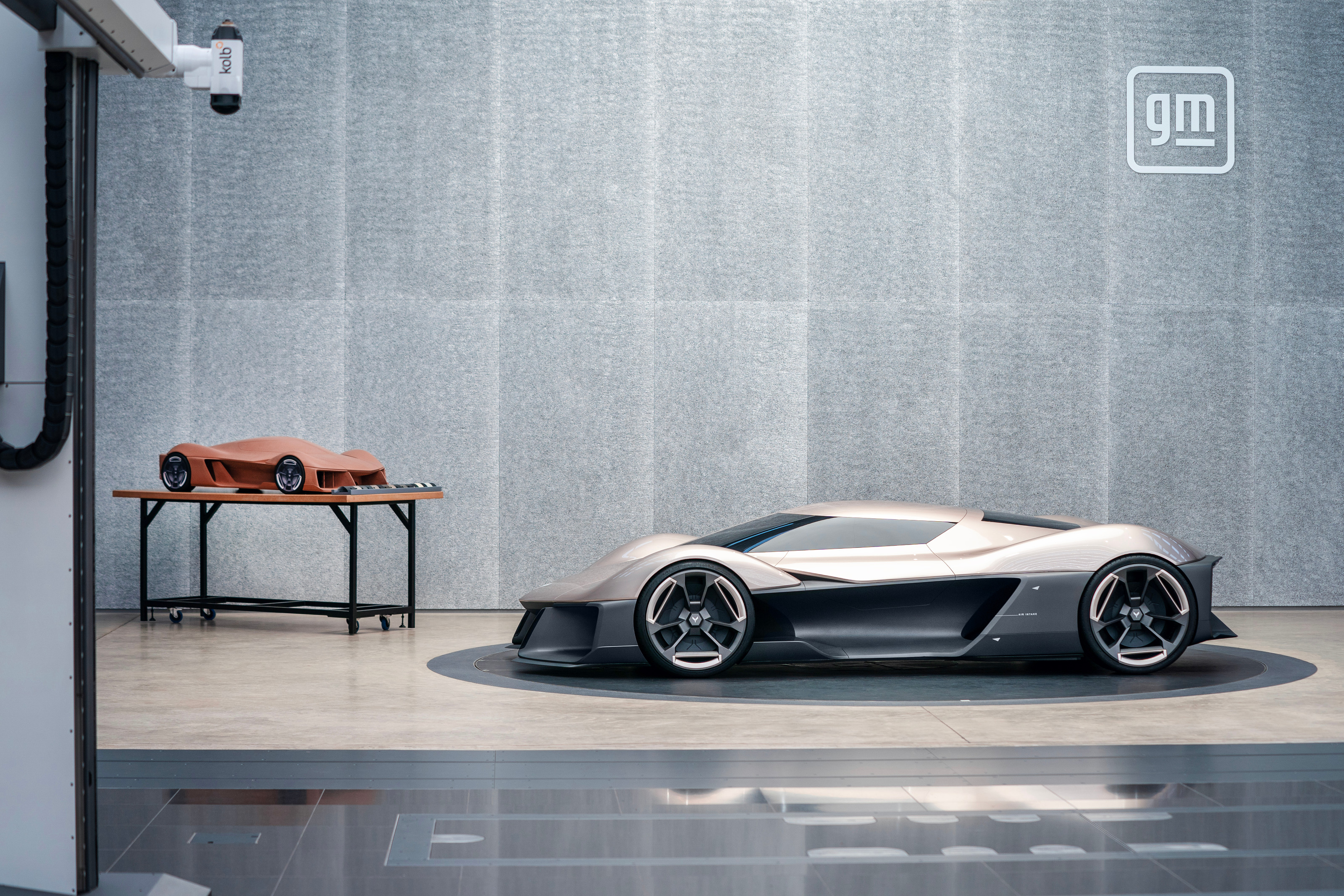
The new Corvette Concept demonstrating the lower half made from recycled tyre material
GM calls this a ‘Corvette-inspired concept’, which is to say that it won’t necessarily be representative of the next generation C9 Corvette – perhaps it’s looking too far ahead. Throughout its history, GM has used the Corvette as a platform for innovation, technically and stylistically. In fact, the Corvette itself has its origins in a concept car, back in the era when the pathway from motor show star to production line could be streamlined. It was Earl, yet again, who initiated the model by taking the EX-122 concept revealed at GM’s Motorama fair in January 1953 and productionising it before year end for an eager public.
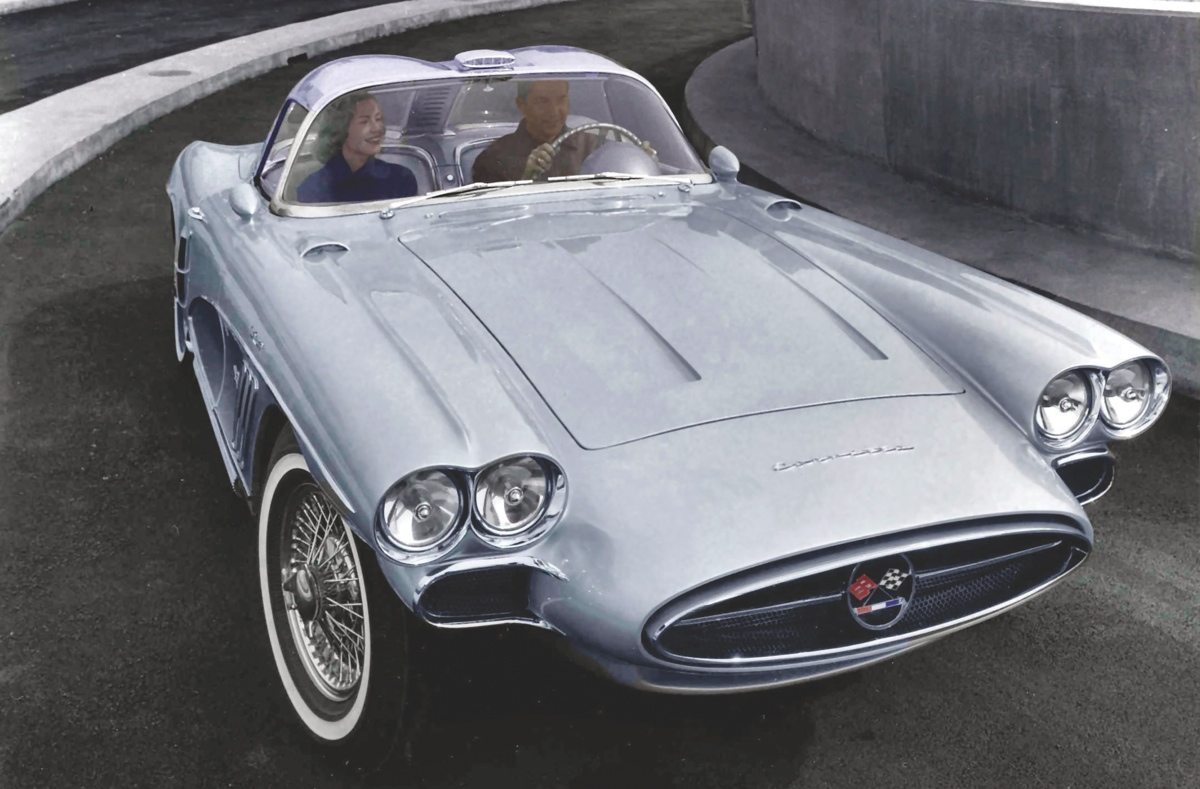
The 1958 Chevrolet Corvette XP-700 concept
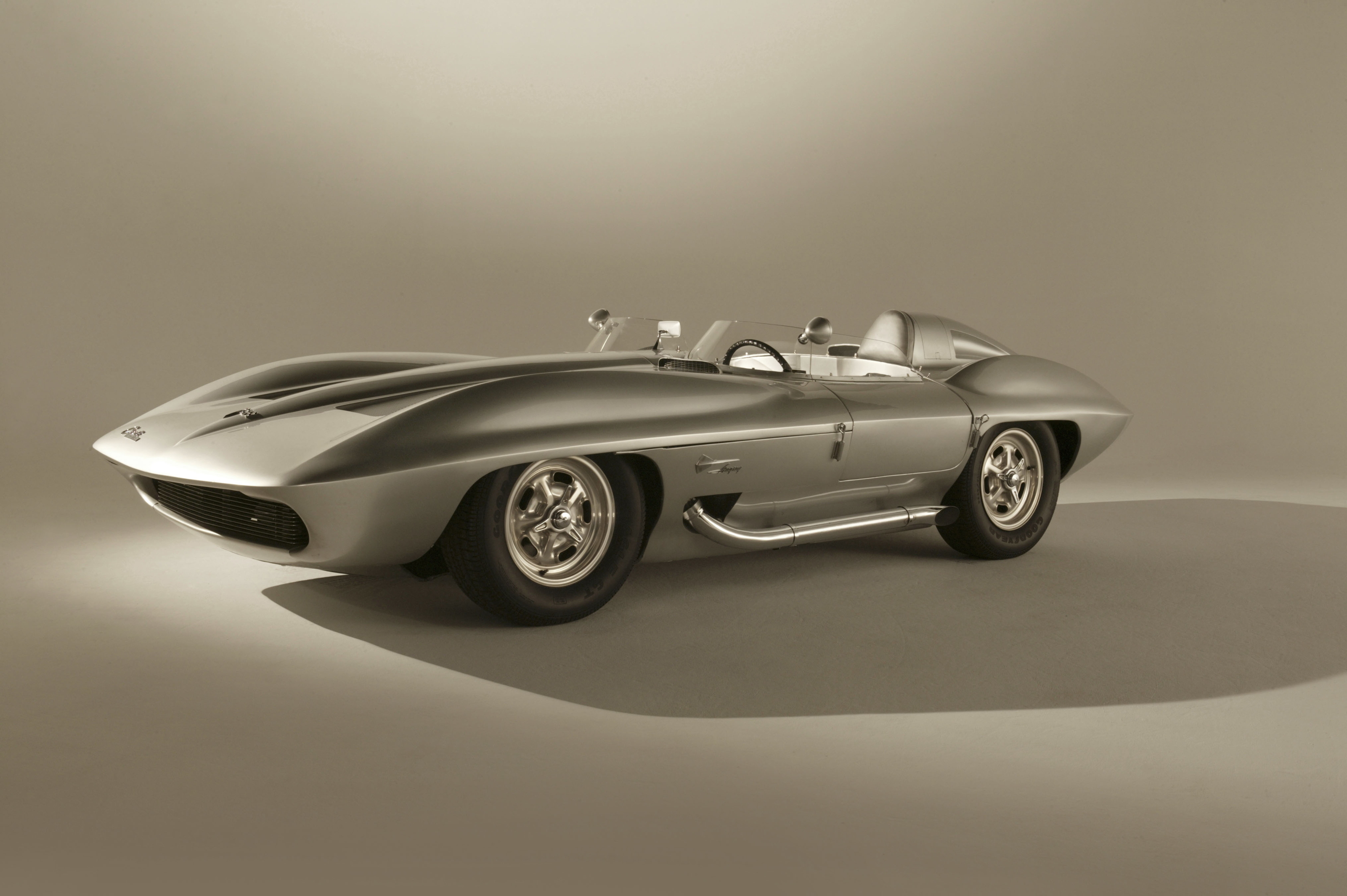
1959 Chevrolet Corvette Stingray Racer concept
Since then, there have been a veritable fleet of other Corvette and Corvette-derived concept cars, some more futuristic than others. There were Corvette concepts in 1958 and 1959 (see above), whilst 1967’s Astro I and the Astro II of 1968 also offer an interesting template – sleek, low mid-engined sports cars that predated the first actual mid-engined Corvette, the current C8, by several decades. Other dramatic design dead-ends included the 1986 Corvette Indy Concept and a wild (but not officially sanctioned) styling exercise by Luigi Colani in 1988.
What we see before us has therefore come from a long and prestigious lineage and points to a hopeful future. ‘C8 is getting us a lot of new customers – this will influence the Corvette brand going forwards,’ says Phil Zak, Global Executive Design Director for Chevrolet.
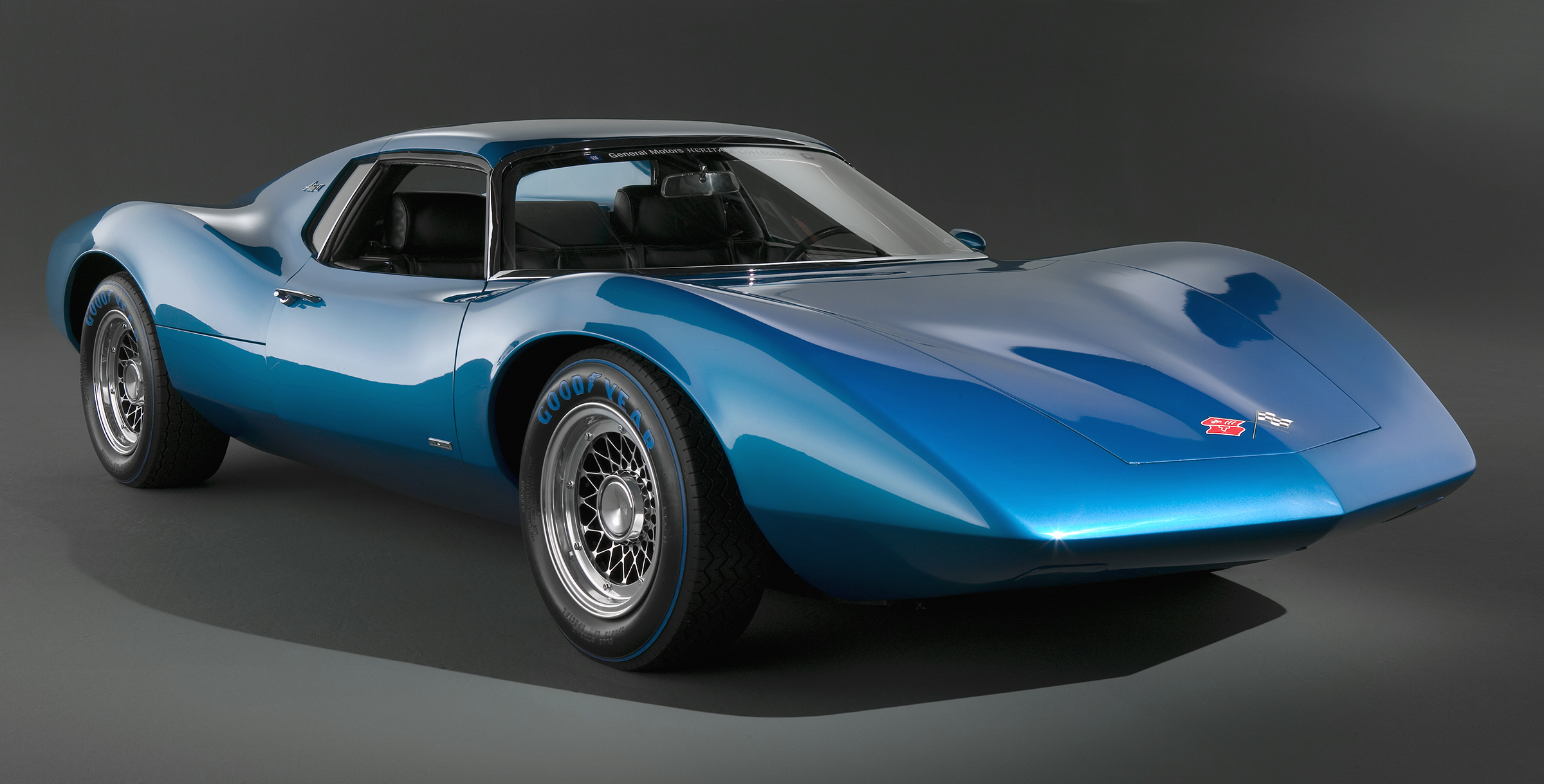
1968 Astro II concept
Behind the scenes at the design studio
It's a relatively small team here in Leamington, just 35 people arranged across the traditional spheres of designing, sculpting, surfacing, packaging and more. The building is set up around clay modelling, with the ground floor plates flanked by viewing galleries, a bank of workstations and direct access to an outdoor viewing garden. Digital tools dovetail with the tactile simplicity of clay. The facility offers a clear pathway from sculptural 3D sketching and modelling in Blender to CAD for packaging, resulting in a ‘digital master set’ that can be sent to the Kolb modelling machines to build up a 40% or full-size clay model.
The studio is also fully enabled for virtual design reviews, using an Unreal-engine powered headset that allows for augmented reality walkarounds of a 3D model, complete with real time lighting and reflections mapped onto its surface. In this way, teams across the globe can enter the same virtual space to discuss – and change – models in real time, all part of an organic iterative creative process. Despite all the technology, you’ll struggle to find a car design – either here or elsewhere – who doesn’t subscribe to the theory that ‘clay is still king’.
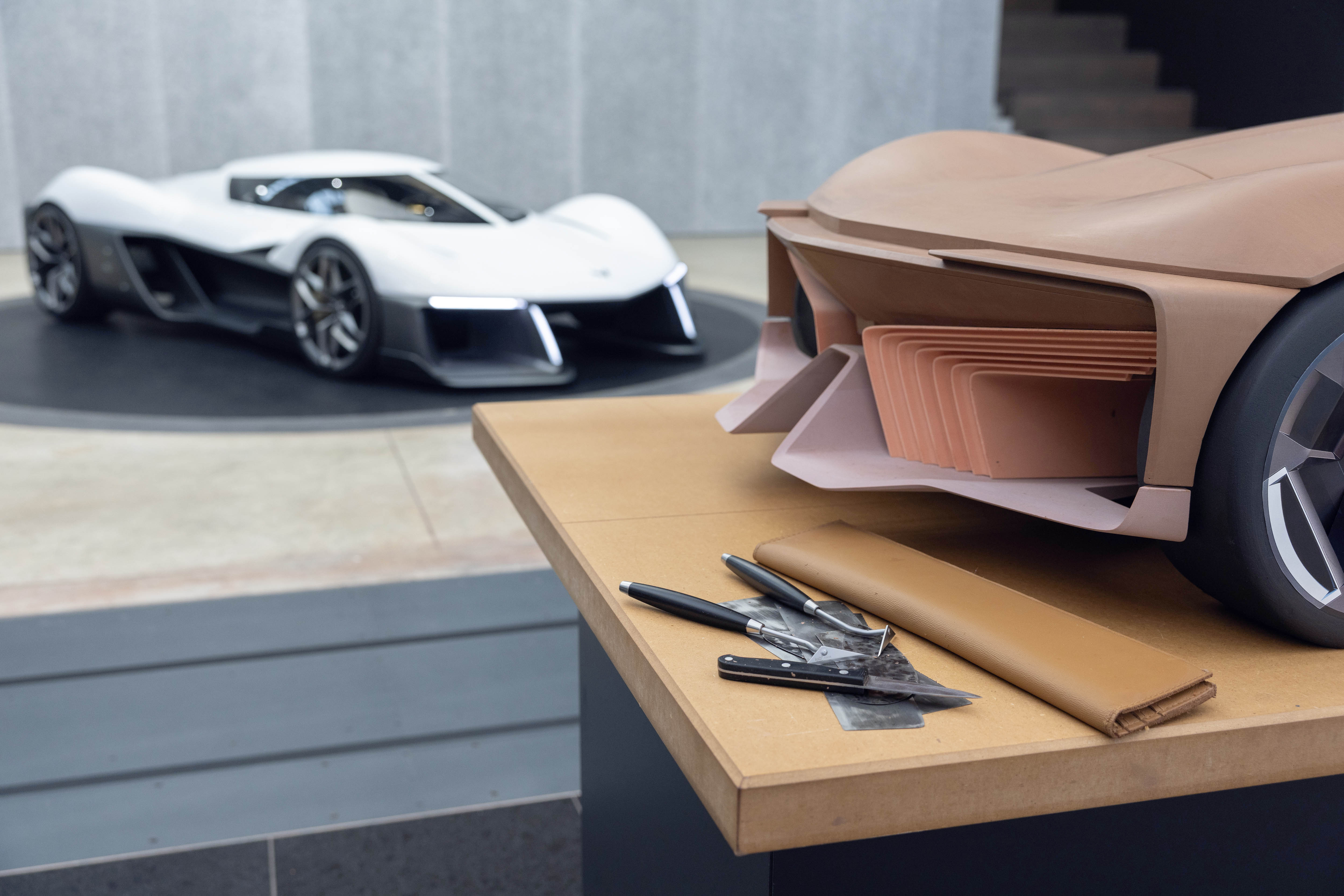
The Corvette Concept alongside a 40% scale model in clay
The interior of this massive shed is quiet and refined, with special detail paid to the lighting and surfaces. The former has an important role to play in the creation and study of surface design, with a complex web of light fixtures suspending above the main modelling area. Walls of aluminium foam panels are used for their acoustic deadening qualities, whilst surfaces and textures are calm and unfussy, all the better to explore automotive form without any distractions.
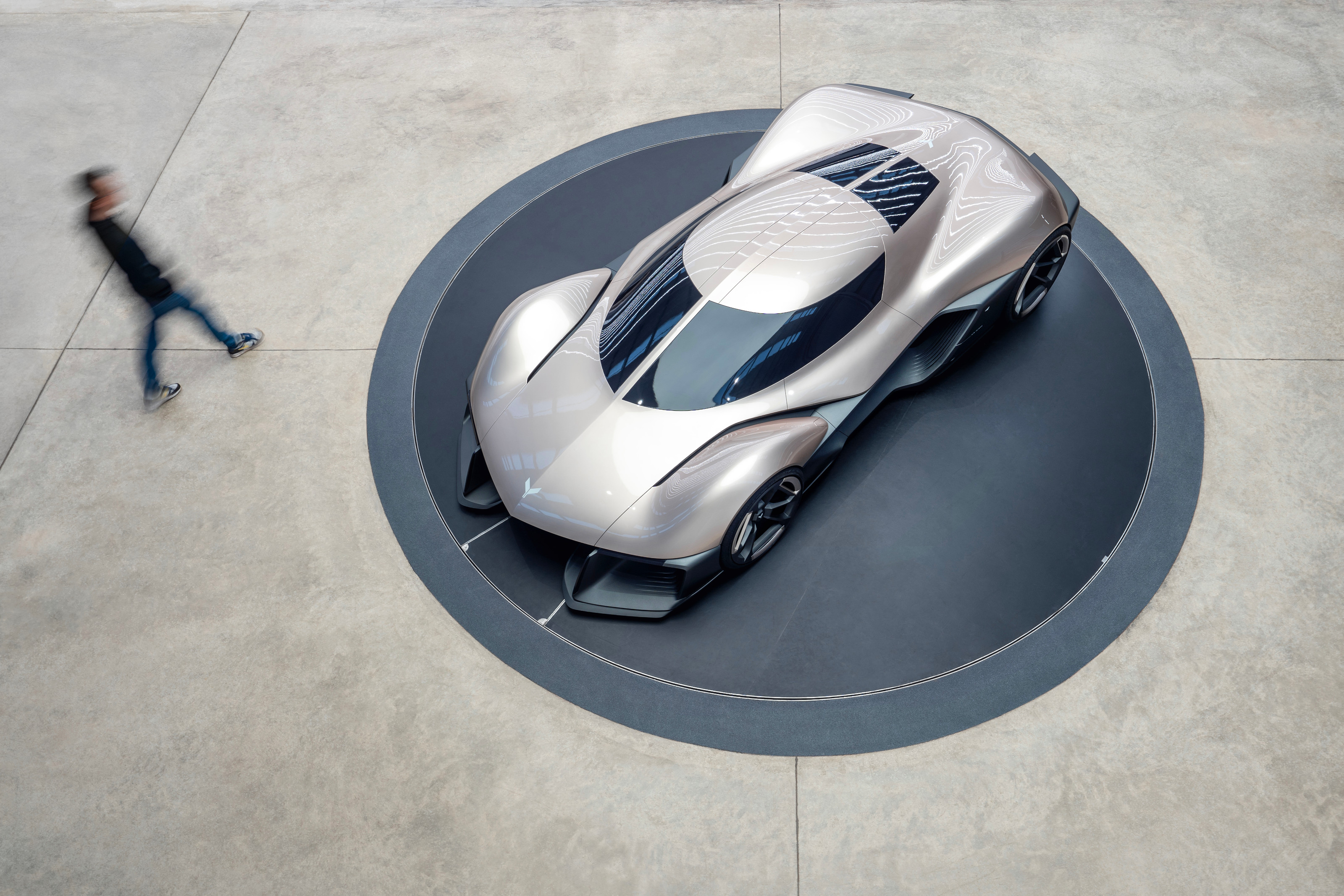
The Corvette Concept in the studio
Throughout the space there are nods to the mid-century architectural stylings of Saarinen’s original Technical Center. Although this facility is very much out of the public eye, there are still flashes of colour and signature furniture choices, along with framed sketches of Saarinen’s spindly, futuristic designs for the American HQ. GM is doubling down on its ‘ownership’ of this aesthetic, recently overhauling one of the key buildings on the Michigan campus, Vanderbilt, to serve as Cadillac House, a public-facing pavilion for its most upmarket brand.
General Motors and the art of global design
According to Michael Simcoe, certain GM brands, notably Cadillac and Chevrolet, have an ‘Americanness that people remember – they have the ideals of America imbued within them,’ citing openness and optimism as values that endure. He won’t be drawn on geopolitical ramifications. ‘A design business is timeless in some ways,’ he says, ‘design is global – [customer] aspirations around the world are very similar. We put our blinkers on for the politics of the day and carry on.’

Michael Simcoe, senior VP of design at General Motors
What we see here will be the first of three explorations of the Corvette form, with two more to follow in the coming months from GM’s American studios in Warren and Pasadena. Together, this trio of Corvette concepts will comprise a snapshot of GM’s advanced design facilities, a distillation of what’s still valid and relevant about this mainstay of American car culture. ‘The three cars will culminate in a single vehicle which we’ll show at the end of the year,’ explains Simcoe, ‘It’s to show that all design thinking doesn’t just come from the US.’
It’s tempting to draw parallels with the four Firebird concept cars, three overseen by Harley Earl in the 1950s and the Firebird IV built for the 1964 New York World’s Fair, four-wheeled expressions of the arrow-straight ambition of the era’s nascent space programme.
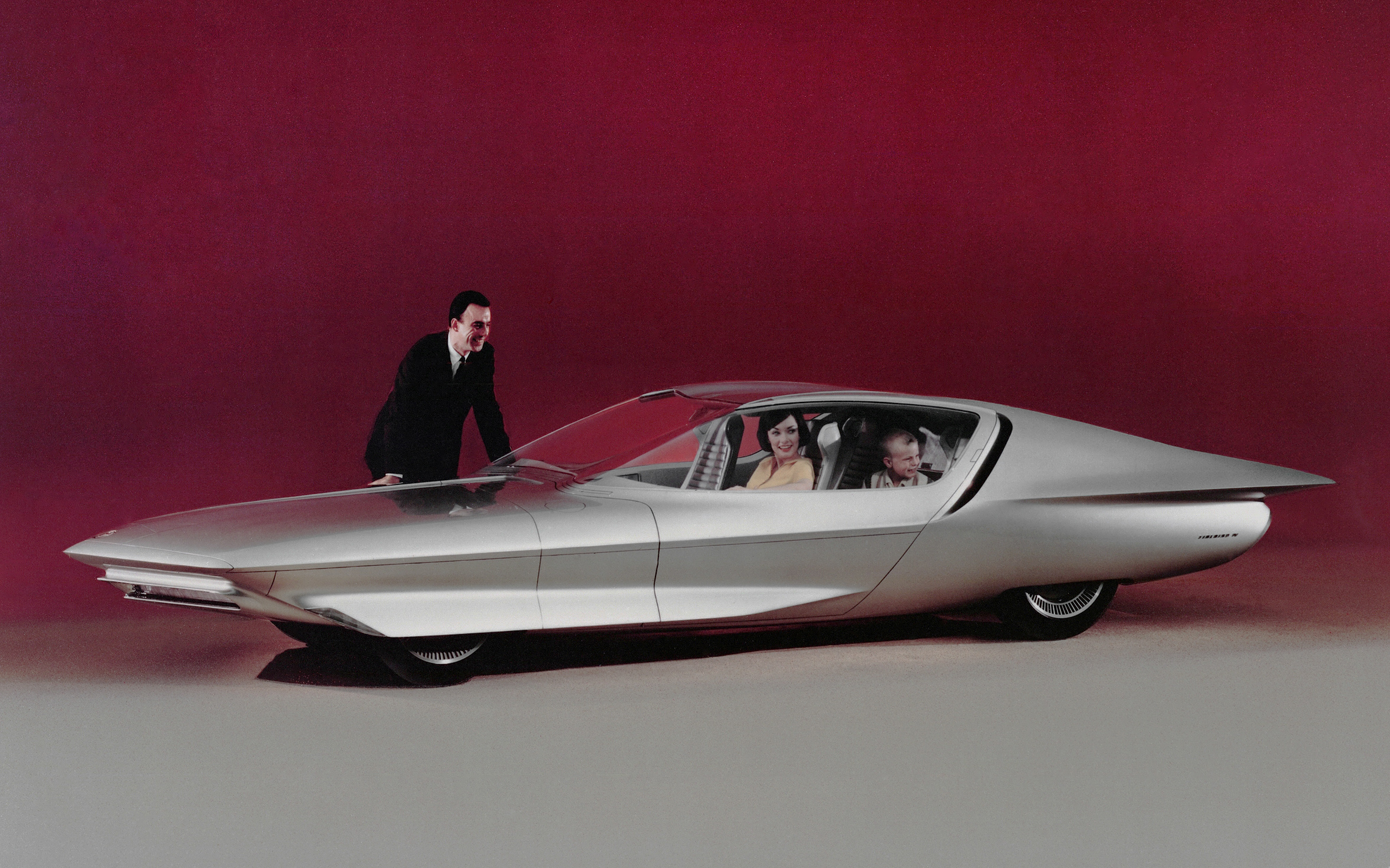
1964 Firebird IV concept
We were also given an off-the-books preview of another concept, developed for one of GM’s more US-centric brands. The UK team was invited by its American counterparts to explore the look and feel of a far-future vehicle and the car we’re shown – previewed in these images – is a world away from the macho posturing of its contemporary equivalents.
This fresh viewpoint isn’t about imposing one set of cultural norms on another. As Sharon Gauci, the Executive Director Design responsible for GM’s Buick and GMC divisions, notes, ‘we operate as one global design team – at the end of the day, a desirable brand is globally desirable.’ Even so, it’s possible to detect a distinctly different ethos at play, as if the concept was European brutalism, with all its essential warmth and humanism and value of art, creativity and abstraction, compared to the American brutalism of might and scale, a path that leads to McMansions and exceptionalism.
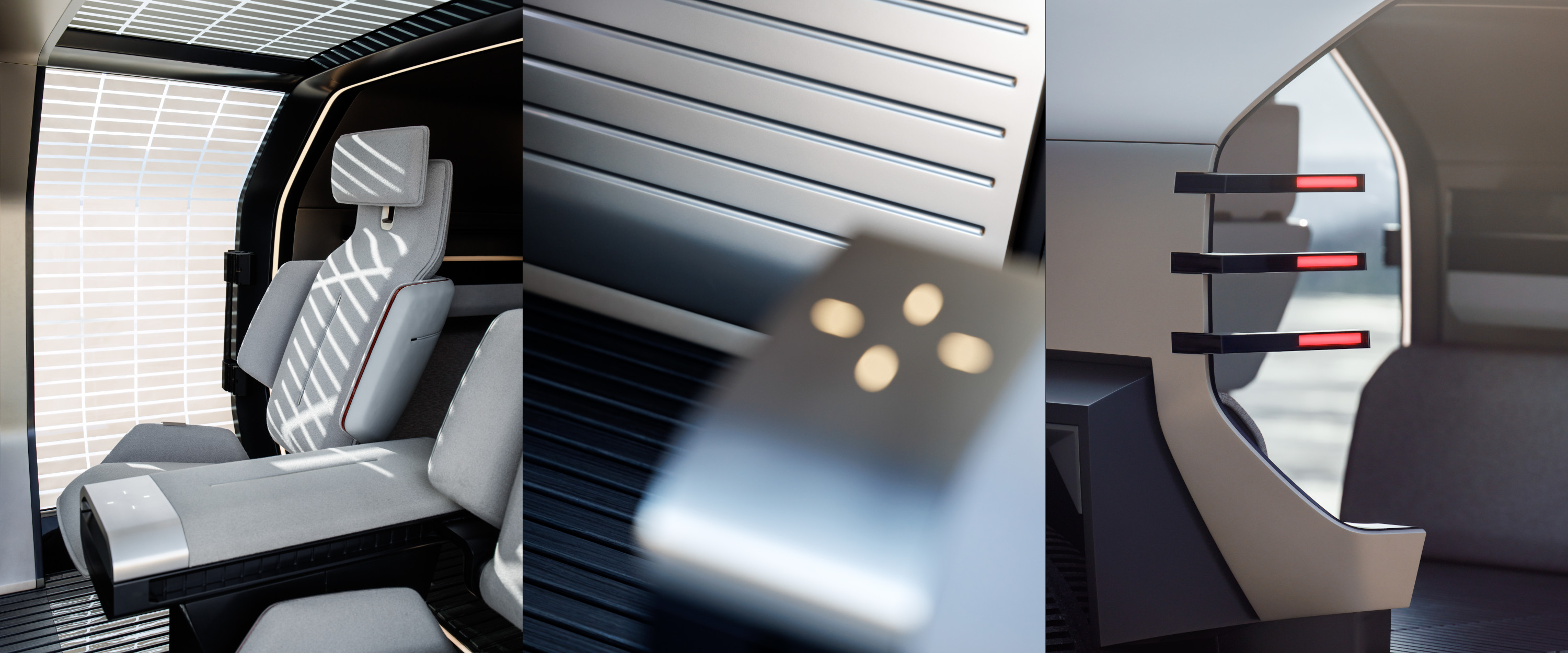
Teaser images from another, unnamed, General Motors concept design
Back in Warren, the main GM design facilities aren’t siloed – everything is out in the open and brands sit alongside one another. That helps with solidifying and defining their individual DNA. ‘We have a look and feel board, along with a set of guiding language and imagery for how we see each brand,’ Sharon Gauci explains, ‘that becomes the north star.’ Three years in the making, the Leamington Spa facility has become another tool in the titanic task of managing GM’s product portfolio.

The new Corvette Concept
Unfortunately for GM, this celebration of one of the icons of American auto design has been unveiled at a time when the country’s political elite is pushing Europe – and almost everyone else – away, economically, culturally and ideologically. No doubt the company would stress that the most powerful engines of corporate success have always been co-operative, cross-border, and transnational.
If, as some commentators are speculating, an era of immersive and inescapable globalisation is drawing to a close, what will that mean for world-spanning operations like GM’s creative network? Undoing such a painstakingly assembled team – closely allied to an even larger network of logistics and manufacturing – would not be easy and almost certainly be self-defeating. It would be the work of another generation to unpick it all, probably in the teeth of fierce opposition.
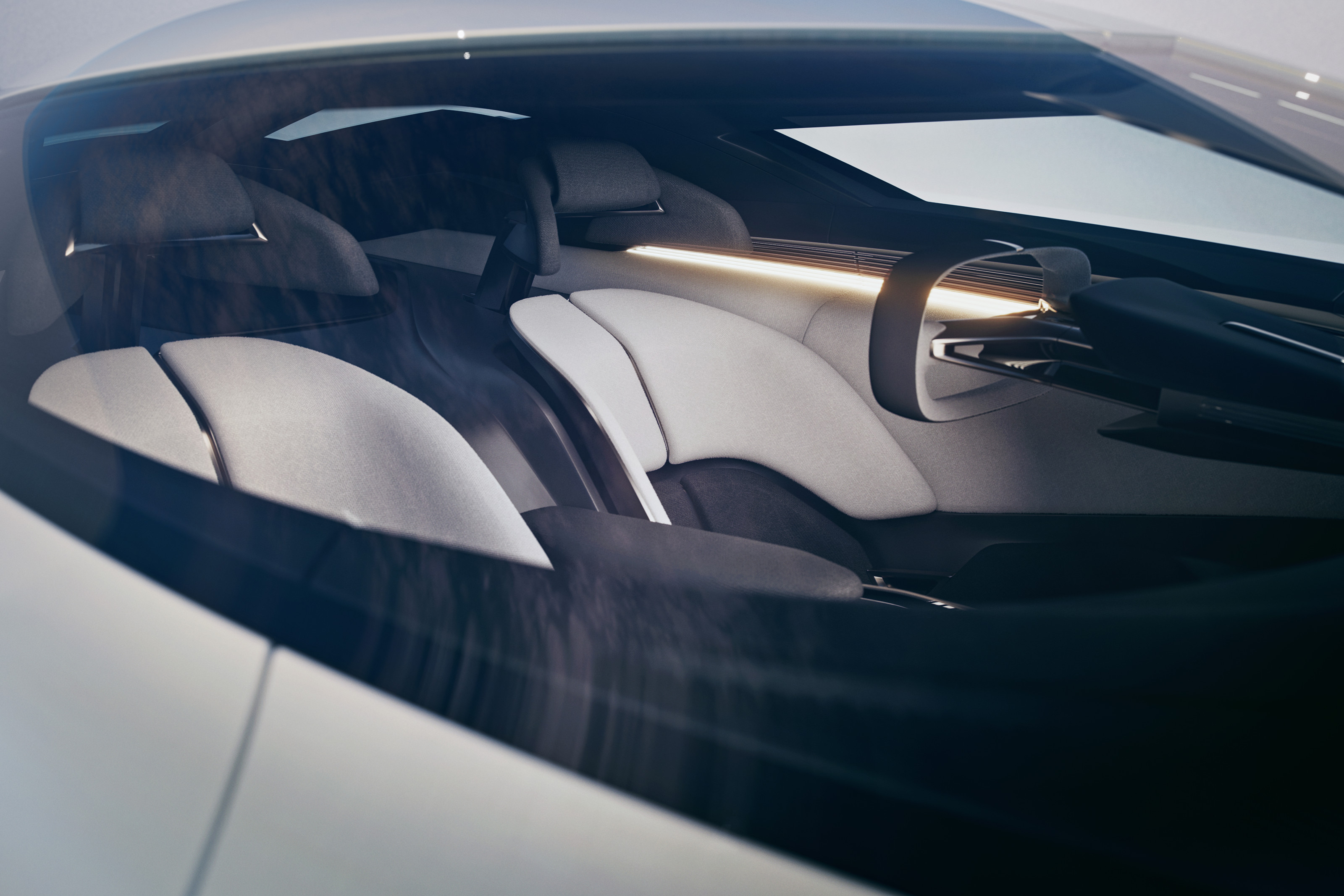
Inside the new Corvette Concept
Regardless of what comes from this conceptual foray into the art and culture of the Corvette, the process has been informative and inspiring, and that's before the concept car has even been seen in public. In common with all car companies, GM has to refine its raw creative output into economically viable products. Although this impressive machine comes from the very company that pioneered concept cars as signifiers of technological and social progress, it’s arrived at a time when such advances feel harder to achieve than ever before. For now, just enjoy the view.
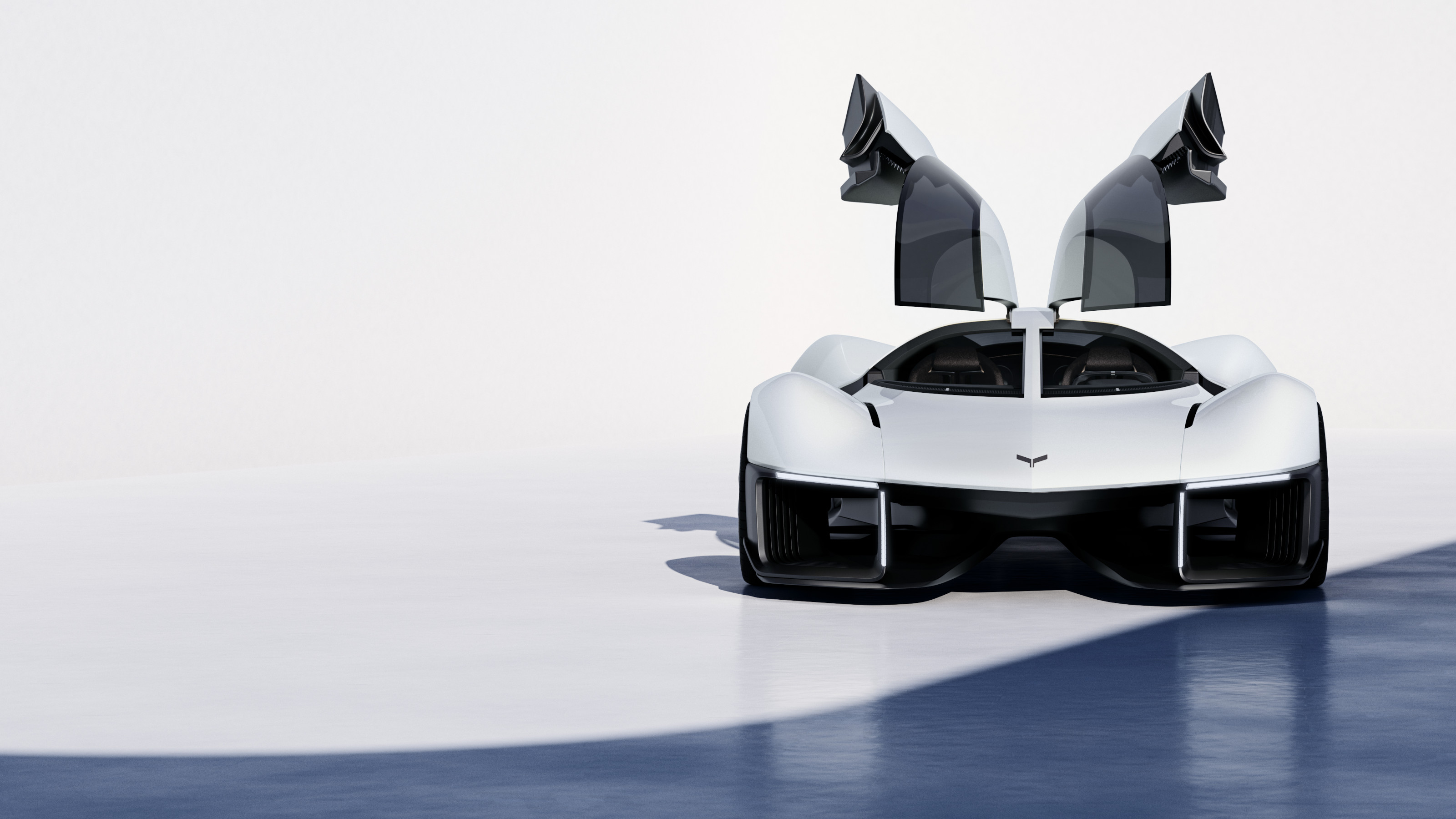
The new Corvette Concept
GM.com, @GeneralMotorsDesign, Chevrolet.com, @CorvetteEurope
Jonathan Bell has written for Wallpaper* magazine since 1999, covering everything from architecture and transport design to books, tech and graphic design. He is now the magazine’s Transport and Technology Editor. Jonathan has written and edited 15 books, including Concept Car Design, 21st Century House, and The New Modern House. He is also the host of Wallpaper’s first podcast.
-
 Fancy a matcha-beer cocktail? Visit this dashing new LA restaurant
Fancy a matcha-beer cocktail? Visit this dashing new LA restaurantCafé 2001 channels the spirit of an American diner with the flow of a European bistro and the artistry of Japanese cuisine
By Carole Dixon
-
 Los Angeles businesses regroup after the 2025 fires
Los Angeles businesses regroup after the 2025 firesIn the third instalment of our Rebuilding LA series, we zoom in on Los Angeles businesses and the architecture and social fabric around them within the impacted Los Angeles neighbourhoods
By Mimi Zeiger
-
 New book 'I-IN' brings together Japanese heritage and minimalist architecture at its finest
New book 'I-IN' brings together Japanese heritage and minimalist architecture at its finestJapanese architecture studio I-IN flaunts its expert command of 21st-century minimalism in a new book by Frame Publishers
By Ellie Stathaki